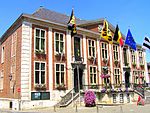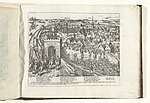Basilica of Our Lady of Scherpenheuvel
1627 establishments in the Spanish Empire17th-century Roman Catholic church buildings in BelgiumBaroque architecture in BelgiumBasilica churches in BelgiumChurch buildings with domes ... and 4 more
Churches in Flemish BrabantCounter-ReformationRoman Catholic churches completed in 1627Shrines to the Virgin Mary

The Basilica of Our Lady of Scherpenheuvel (Dutch: Basiliek van Onze-Lieve-Vrouw van Scherpenheuvel, French: Basilique de Notre Dame de Montaigu) is a Roman Catholic parish church and minor basilica in Scherpenheuvel-Zichem, Belgium. The church was consecrated in 1627 and raised to the status of a minor basilica in 1922. It is reputedly the most frequently visited shrine of pilgrimage in Belgium. While the cult on the Scherpenheuvel (or Sharp Hill) is older, its present architectural layout and its enduring importance are due to the patronage of the Archdukes Albert and Isabella and the Counter-Reformation.
Excerpt from the Wikipedia article Basilica of Our Lady of Scherpenheuvel (License: CC BY-SA 3.0, Authors, Images).Basilica of Our Lady of Scherpenheuvel
Albertusplein,
Geographical coordinates (GPS) Address External links Nearby Places Show on map
Geographical coordinates (GPS)
| Latitude | Longitude |
|---|---|
| N 50.980277777778 ° | E 4.9783333333333 ° |
Address
Basiliek van Onze-Lieve-Vrouw van Scherpenheuvel
Albertusplein
3270
Flemish Brabant, Belgium
Open on Google Maps









